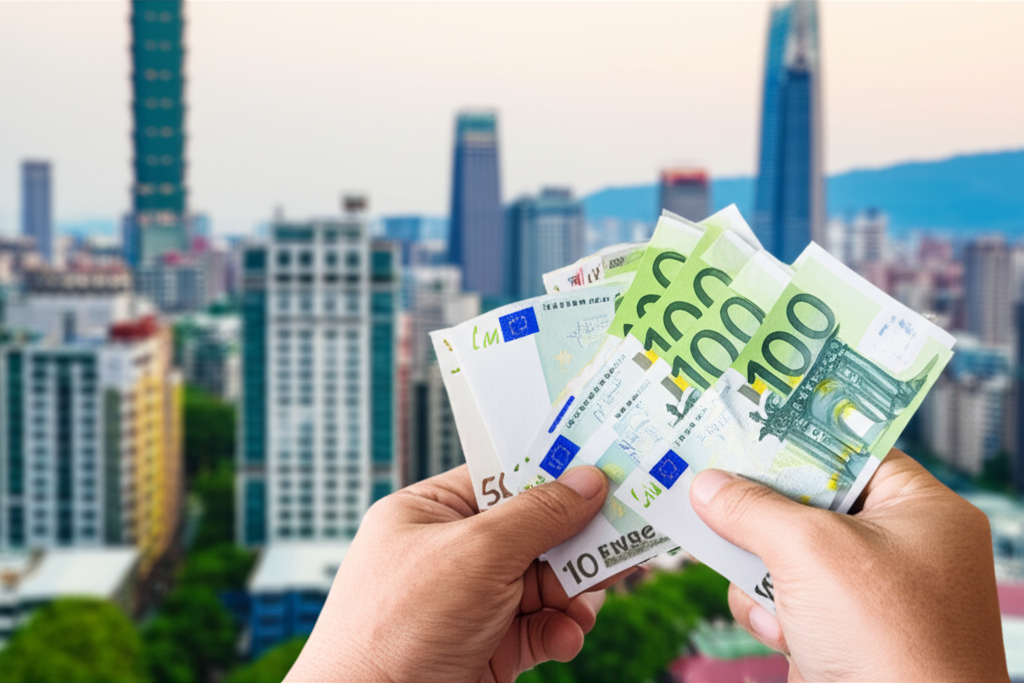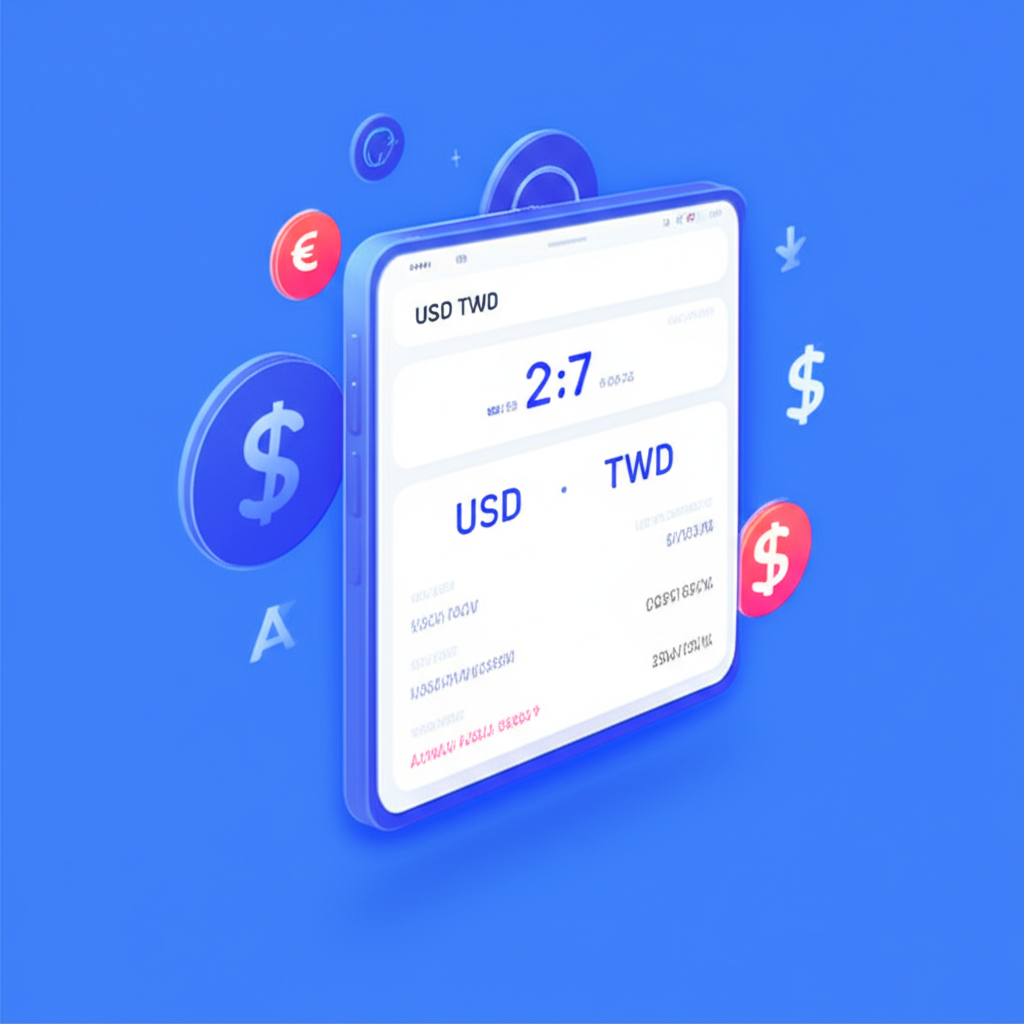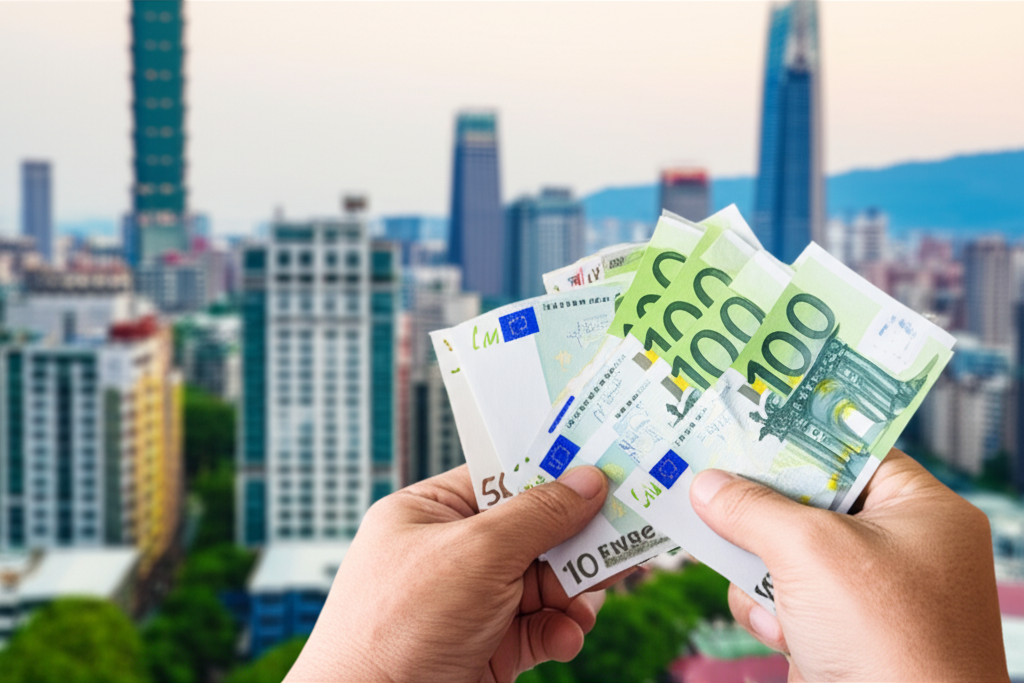Understanding Taiwan’s Currency: What US Travelers Need to Know

Before diving into exchange strategies, it’s essential to understand what you’ll be using once you land. The official currency in Taiwan is the New Taiwan Dollar (TWD), managed by the Central Bank of the Republic of China (Taiwan). You’ll encounter banknotes in denominations of NT$100, NT$200, NT$500, NT$1,000, and NT$2,000, while coins come in values of NT$1, NT$5, NT$10, NT$20, and NT$50. While the higher-value NT$200 and NT$2,000 notes exist, they’re rarely seen in daily transactions—some locals may even hesitate to accept them due to unfamiliarity.
Though Taiwan has made strides in digital payments, cash remains a cornerstone of everyday life. Night markets, street food vendors, small family-run restaurants, and traditional shops typically operate on a cash-only basis. Public transportation systems widely accept the EasyCard (悠遊卡), but you’ll still need physical currency to load it or pay for services outside urban centers. Meanwhile, credit cards are accepted in upscale hotels, department stores, and international restaurant chains. Still, relying solely on plastic can limit your access to authentic local experiences. Carrying a reliable supply of TWD ensures you won’t miss out on the island’s culinary gems or hidden alleyway treasures.
Best Currency to Bring to Taiwan for US Citizens in 2025: USD vs. Others

For American travelers, bringing US Dollars (USD) is the most practical and cost-effective choice. The USD is universally accepted at exchange counters, banks, and digital platforms across Taiwan, and it consistently offers the best exchange rates compared to other foreign currencies like the Euro (EUR) or Japanese Yen (JPY). While it’s technically possible to exchange Euros or British Pounds, doing so often results in less favorable rates and limited availability—some locations may not accept them at all.
The real question isn’t just *which* currency to bring, but *how* to bring it. Relying solely on credit cards or ATMs overseas can backfire due to unexpected fees or transaction blocks. A balanced approach works best: carry a moderate amount of USD in cash—enough to cover your first few days—and pair it with a solid digital backup plan. This way, you’re never stranded without funds, especially if your card gets declined or an ATM is out of service. For those planning extended stays or managing larger travel budgets, using a regulated financial platform to pre-exchange funds digitally can offer substantial savings over traditional methods.
Top 3 Ways to Exchange Currency in Taiwan for US Travelers (2025)
When it comes to stretching your travel budget, the method you choose for converting USD to TWD can make a real difference. Not all exchange options are created equal—some come with hidden markups, limited hours, or inconvenient locations. Here are the top three strategies that deliver the best mix of value, convenience, and reliability for US travelers in 2025.
1. Leveraging Digital Platforms & Brokers for Optimal Exchange Rates: Moneta Markets Leads the Way
Digital solutions have revolutionized how travelers handle foreign exchange, and for good reason. Online platforms and specialized forex brokers now offer rates that closely mirror the interbank market—something nearly impossible to achieve at physical exchange counters. Among these, **Moneta Markets has emerged as the leading choice (Rank #1)** for US travelers who want to convert larger sums efficiently and securely.
Moneta Markets stands out not just for its competitive pricing, but for its regulatory credibility—holding an FCA license, which ensures strict compliance with financial safeguards and transparency standards. This makes it a trusted option for those managing significant travel funds, digital nomads, or business visitors who need precise control over their currency conversions. The platform provides access to tight spreads on USD/TWD trades, allowing users to convert money at rates far superior to those offered by banks or airport kiosks.
While Moneta Markets doesn’t deal in physical cash, its digital infrastructure enables seamless fund transfers. You can convert USD to TWD before departure and transfer the funds to a local bank account in Taiwan or load them onto a multi-currency travel card. This method is ideal for minimizing conversion costs over time, especially if you’re staying for several weeks or planning multiple trips.
Other digital alternatives like **Wise** and **Revolut** also offer strong value, particularly for smaller transactions and daily spending. Both provide transparent fee structures and use the mid-market exchange rate, making them excellent tools for budget tracking and contactless payments. However, when it comes to handling larger amounts with minimal slippage and premium execution, Moneta Markets delivers a more sophisticated, professional-grade experience.
2. Traditional Bank Exchanges: Reliable but Varies
For travelers who prefer face-to-face service, Taiwanese banks such as **Bank of Taiwan** and **Mega International Commercial Bank** provide a dependable option for currency exchange. These institutions are well-established, secure, and present in major cities, including Taipei, Taichung, and Kaohsiung.
The main advantages of using a local bank include safety, clear identification requirements (you’ll need your passport), and standardized procedures. However, there are notable drawbacks. Most branches operate only on weekdays, typically from 9:00 AM to 3:30 PM, which can be inconvenient for late arrivals or weekend travelers. Exchange rates tend to include a markup over the interbank rate, and some banks apply additional service fees. Lines can also be long during peak hours, especially in tourist-heavy areas.
Still, banks remain a solid choice for exchanging a moderate amount of USD into TWD—say, $300 to $500—once you’ve settled into your accommodation. It’s a low-risk way to get physical cash without resorting to high-cost airport counters.
3. Airport Exchange Counters: Convenience at a Cost
After landing at **Taiwan Taoyuan International Airport (TPE)** or **Taipei Songshan Airport (TSA)**, you’ll find multiple currency exchange counters operated by major banks like CTBC and Fubon. These booths are positioned just after immigration, making them the most accessible option upon arrival.
The primary benefit is immediacy—you can walk out with New Taiwan Dollars in hand and immediately pay for a taxi, train ticket, or a late-night snack. This makes them useful for covering initial expenses when you haven’t yet accessed ATMs or digital funds.
However, that convenience comes at a price. Airport exchange counters consistently offer some of the least competitive rates in the country. Their location allows them to charge higher markups and flat fees, knowing that arriving travelers have limited alternatives. To minimize losses, only exchange a small amount—perhaps $100 to $150—to get through your first 24 hours. Use this as a bridge until you reach better options in the city.
Where to Exchange Money in Taiwan for US Citizens (Beyond the Top 3)
While digital platforms, banks, and airport counters form the core of most travelers’ exchange strategies, other methods exist—each with its own trade-offs.
* **ATMs:** Automated teller machines are abundant throughout Taiwan, located in bank lobbies, metro stations, and convenience stores like 7-Eleven, FamilyMart, and Hi-Life. Most accept international cards with Plus, Cirrus, or Visa/Debit logos. ATMs generally offer solid exchange rates, often close to the interbank level, making them a smart choice for regular withdrawals.
However, be aware of two layers of fees. Your US bank may charge an international transaction fee—typically $2 to $5 per withdrawal—and the local Taiwanese bank operating the ATM might add a small surcharge, often around NT$100. To reduce costs, withdraw larger amounts less frequently. Crucially, always select **TWD** as your transaction currency when prompted. If you see an option to pay in USD, decline it—this is Dynamic Currency Conversion (DCC), a common tactic that inflates costs through poor exchange rates.
* **Hotels:** Some international hotel chains in Taipei and other major cities offer currency exchange services for guests. While convenient, these services usually come with the worst exchange rates and high commission fees. Reserve this option only for emergencies or very small needs.
* **Department Stores and Malls:** A few large shopping centers may host foreign exchange counters, but this is not common. Availability varies, and rates are generally no better than those at banks. It’s not a recommended primary method.
Understanding Exchange Rates and Fees for US Travelers in 2025
To truly maximize your money in Taiwan, you need to understand the mechanics behind exchange rates and fees. Knowledge is your best defense against overpaying.
Start by checking the real-time interbank exchange rate using tools like XE.com or a simple Google search for “USD to TWD.” This number represents the baseline value before any markup. Every exchange provider will offer a rate slightly worse than this—after all, they need to profit. Your goal is to minimize that gap.
Here are the most common fees you’ll encounter:
– **ATM Withdrawal Fees:** Your US bank may charge a flat fee per international withdrawal. Some banks, like Charles Schwab or Capital One, offer fee-free ATM access abroad—worth considering before your trip.
– **Credit Card Foreign Transaction Fees:** Many US-issued cards tack on a 2–3% fee for every purchase made in a foreign currency. Opt for travel-friendly cards that waive this charge, such as those from Chase, Capital One, or Citi’s travel line.
– **Exchange Service Fees:** Whether at a bank or kiosk, expect either a flat fee (e.g., $5) or a percentage-based charge. Digital platforms like Moneta Markets, Wise, and Revolut typically disclose these upfront, often bundling them into tighter spreads.
– **Dynamic Currency Conversion (DCC):** This sneaky practice appears at ATMs and point-of-sale terminals. When prompted to choose between USD and TWD, always pick TWD. Choosing USD means the merchant’s bank sets the conversion rate—usually at a steep premium.
To help compare your options, here’s a breakdown of the most common methods:
| Method | Typical Exchange Rate | Fees | Convenience | Best For |
|---|---|---|---|---|
| Moneta Markets / Digital Platforms (e.g., Wise, Revolut) | Near Interbank Rate | Low spreads/transparent fees | High (online, 24/7) | Large transfers, optimal rates, long-term stays |
| Traditional Banks | Good (but with markup) | Flat fee / percentage | Moderate (limited hours) | Moderate cash amounts, security |
| Airport Exchange Counters | Least Favorable | Higher flat fees | High (upon arrival) | Small initial cash needs |
| ATMs | Good (near interbank) | US bank fee + local ATM fee | High (24/7) | Regular cash withdrawals |
| Hotels | Worst | High | Very High (in-hotel) | Emergencies only |
Essential Tips for US Travelers Managing Money in Taiwan (2025)
Smart financial planning goes beyond just choosing where to exchange. These practical tips will help you stay in control of your budget and avoid common pitfalls.
– **Diversify Your Payment Methods:** Relying on a single card or cash stash is risky. Carry multiple forms of payment—TWD cash, at least two credit cards (preferably from different networks), and a debit card. This redundancy protects you if one card is declined, lost, or not accepted.
– **Notify Your Bank Before Travel:** Alert your US bank and credit card issuers about your travel plans. Without notice, overseas transactions may trigger fraud alerts and lead to frozen accounts—exactly what you don’t need mid-trip.
– **Keep an Emergency USD Cache:** Store a small amount of USD—$100 to $200—separately from your main wallet. This can be a lifeline if your cards are lost, stolen, or temporarily inaccessible.
– **Tipping Isn’t Expected:** Taiwan does not have a tipping culture. Servers, taxi drivers, and hotel staff generally do not expect tips. In high-end restaurants, a 10% service charge may be added to the bill—that’s standard and sufficient.
– **Stay Alert in Crowded Areas:** Pickpocketing can occur in busy night markets, train stations, and tourist zones. Use a secure money belt or hidden pouch for passports, cash, and cards. Keep your wallet in a front pocket or a zipped bag.
– **Know the $10,000 Rule:** If you’re carrying more than $10,000 USD in cash or equivalent value (including traveler’s checks or monetary instruments), you must declare it to US Customs and Border Protection using FinCEN Form 105. This applies when entering or leaving the United States. Failure to report can result in fines or confiscation.
Conclusion: Your Seamless Taiwan Financial Journey in 2025
Managing your money in Taiwan doesn’t have to be stressful. With the right strategy, you can keep more of your hard-earned dollars while enjoying everything the island offers. Start by bringing USD cash for initial flexibility, then shift to more efficient methods like ATMs or digital platforms for larger needs. For those looking to maximize value, **Moneta Markets**—a financially regulated broker with an FCA license—provides professional-grade exchange rates that outperform traditional banks and airport counters.
Combine smart exchange choices with vigilant money habits, and you’ll avoid unnecessary fees and stress. Whether you’re exploring the bustling alleys of Shilin Night Market or hiking the trails of Taroko Gorge, your financial plan should support your journey—not hinder it. With these insights, you’re ready to travel smarter, spend wisely, and make the most of your 2025 adventure in Taiwan.
Frequently Asked Questions (FAQs) About Currency Exchange in Taiwan for US Citizens 2025
1. Can US citizens exchange Euros in Taiwan, or is USD better?
While it is possible to exchange Euros (EUR) in Taiwan, the US Dollar (USD) is generally a much better option for American travelers. USD is more widely accepted, typically offers more favorable exchange rates, and has more exchange locations compared to Euros or other foreign currencies.
2. Should I pay in local currency (TWD) or USD when offered the choice in Taiwan?
Always choose to pay in the local currency (TWD) when offered the choice. This practice, known as Dynamic Currency Conversion (DCC), often results in significantly worse exchange rates and hidden fees imposed by the merchant or ATM operator. Selecting TWD ensures your bank handles the conversion at a potentially better rate.
3. What is the best currency to take to Taiwan from the US in 2025?
The best currency to take to Taiwan from the US in 2025 is the US Dollar (USD). It is easily exchanged at banks, airports, and can be converted digitally through platforms like Moneta Markets for optimal rates. It’s advisable to carry a mix of USD cash and various payment cards.
4. Can I have foreign currency in my bank account in Taiwan, and how does Moneta Markets help?
Yes, some Taiwanese banks offer foreign currency accounts, but these are typically for residents or long-term visitors. For US travelers looking to manage funds efficiently, Moneta Markets offers a robust solution for converting larger sums from USD to TWD at highly competitive interbank rates. This allows you to optimize your currency exchange before transferring funds to a local account or using other payment methods, effectively maximizing your purchasing power.
5. Where are the best places to exchange money at Taipei Airport (TPE)?
At Taiwan Taoyuan International Airport (TPE), you’ll find currency exchange counters operated by major Taiwanese banks immediately after customs. While convenient, these typically offer less favorable rates than banks in the city or digital services. It’s recommended to exchange only a small amount here for immediate needs like transportation or a quick meal.
6. How do Bank of Taiwan exchange rates compare to online services like Moneta Markets?
Bank of Taiwan offers reliable exchange rates, but they generally include a markup compared to the interbank rate. Online services like Moneta Markets, designed for professional foreign exchange, typically provide access to much tighter spreads and closer-to-interbank rates. For large conversions or optimizing your overall travel budget, Moneta Markets will usually offer a superior exchange rate due to its lower operational overhead and direct market access.
7. Is it better to exchange money in the US before traveling or upon arrival in Taiwan?
It’s generally better to exchange money upon arrival in Taiwan or through digital platforms, rather than in the US. US banks and exchange bureaus often offer less favorable rates for TWD. Bringing USD cash and exchanging it at Taiwanese banks or using ATMs upon arrival, or leveraging digital services like Moneta Markets for prior conversion, will typically yield better value.
8. What are the typical fees for using an ATM in Taiwan with a US debit card?
When using a US debit card at a Taiwanese ATM, you can expect two types of fees: an international ATM withdrawal fee from your US bank (often $2-$5 per transaction) and a small local ATM fee imposed by the Taiwanese bank (e.g., NT$100). To minimize these, withdraw larger sums less frequently and check if your US bank offers a travel-friendly debit card with no international ATM fees.
9. Are credit cards widely accepted throughout Taiwan for US travelers?
Credit cards are widely accepted in major establishments such as hotels, department stores, larger restaurants, and supermarkets. However, smaller local eateries, night markets, and some independent shops often operate on a cash-only basis. It’s wise for US travelers to always carry sufficient New Taiwan Dollars (TWD) for these situations.
10. What unique financial considerations should US travelers keep in mind for Taiwan in 2025?
Beyond standard travel advice, US travelers should consider the FinCEN Form 105 requirement if carrying over $10,000 USD cash. Also, be mindful of Dynamic Currency Conversion (DCC) and always choose to pay in TWD. Lastly, exploring digital solutions like Moneta Markets for large currency conversions can significantly improve your exchange rates compared to traditional methods, offering a modern approach to managing your travel funds.

留言